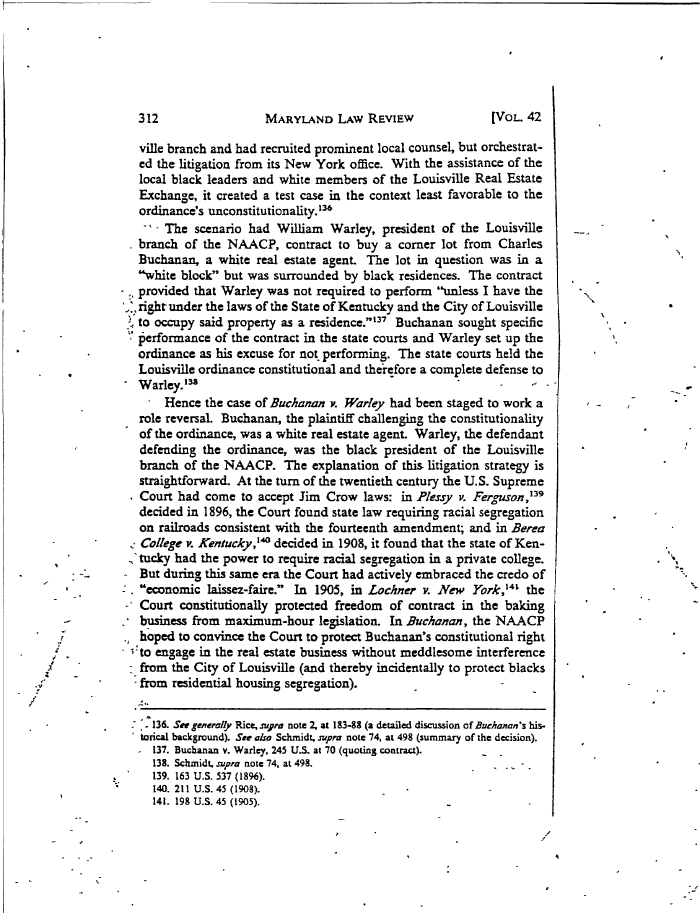 |
||||
|
Garrett Power, Apartheid Baltimore Style: The Residential Segregation Ordinances of 1910-1913, Maryland Law Review, 42 (1983) , Image No: 25 Enlarge and print image (61K) << PREVIOUS NEXT >> |
 |
||||
|
Garrett Power, Apartheid Baltimore Style: The Residential Segregation Ordinances of 1910-1913, Maryland Law Review, 42 (1983) , Image No: 25 Enlarge and print image (61K) << PREVIOUS NEXT >> |
| 312 MARYLAND LAW REVIEW [VOL. 42 ville branch and had recruited prominent local counsel, but orchestrat- ed the litigation from its New York office. With the assistance of the local black leaders and white members of the Louisville Real Estate Exchange, it created a test case in the context least favorable to the ordinance's unconstitutionality.136 The scenario had William Warley, president of the Louisville - branch of the NAACP, contract to buy a corner lot from Charles Buchanan, a white real estate agent The lot in question was in a "white block" but was surrounded by black residences. The contract provided that Warley was not required to perform '^unless I have the right under the laws of the State of Kentucky and the City of Louisville to occupy said property as a residence."137 Buchanan sought specific performance of the contract in the state courts and Warley set up the ordinance as his excuse for not performing. The state courts held the Louisville ordinance constitutional and therefore a complete defense to Warley.138 Hence the case of Buckanan v. Warley had been staged to work a role reversal. Buchanan, the plaintiff challenging the constitutionality of the ordinance, was a white real estate agent. Warley, the defendant defending the ordinance, was the black president of the Louisville branch of the NAACP. The explanation of this litigation strategy is straightforward. At the turn of the twentieth century the U.S. Supreme Court had come to accept Jim Crow laws: in Plessy v. Ferguson,139 decided in 1896, the Court found state law requiring racial segregation on railroads consistent with the fourteenth amendment; and in Berea College v. Kentucky,140 decided in 1908, it found that the state of Ken- . tucky had the power to require racial segregation in a private college. But during this same era the Court had actively embraced the credo of "economic laissez-faire." In 1905, in Lochner v. New York,140 the Court constitutionally protected freedom of contract in the baking business from maximum-hour legislation. In Buchanan, the NAACP hoped to convince the Court to protect Buchanan's constitutional right :to engage in the real estate business without meddlesome interference from the City of Louisville (and thereby incidentally to protect blacks from residential housing segregation). 136. SeĢ generally Rice, supra note 2, at 183-88 (a detailed discussion of Buchanan's his- torical background). See also Schmidt, supra note 74, at 498 (summary of the decision). - 137. Buchanan v. Warley, 245 U.S. at 70 (quoting contract). 138. Schmidt, supra note 74, at 498. ._ - 139. 163 U.S. 537 (1896). 140. 211 U.S. 45 (1908). 141. 198 U.S. 45 (1905). |